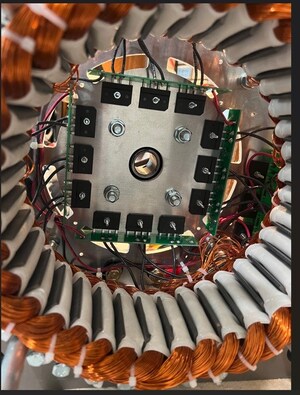105.34% Efficiency at 530 RPM with a 15 KW Generator
DELTONA, Fla., Jan. 10, 2022 /PRNewswire/ -- A small Florida corporation, The Franklin-Thomas Company (FTC), demonstrated today a DC generator that showed an over-unity result. Over-unity means that the generator produced more electrical power (watts) than watts consumed in the production of the power. Put simply – more power out than power in.
While over-unity may seem impossible, the president of FTC, Joe Shepard, showed a video test of the event. The faster Shepard spun the generator under test with a tiny 1,000 watt motor, the higher efficiency climbed. He also put the video on YouTube - https://youtu.be/UBCLRBh9O-o . Shepard further went on to state that the generator tested will be publicly shown at Infinity Industrial Controls in Clearwater, FL on Saturday, January 15th. There will be Zoom availability as well - Chris Rath [email protected]. Because of the importance of his invention, Shepard wants people to see the efficiency for themselves.
Shepard explained the over-unity was due to his circuitry and arrangement of the magnets. As a result, generators now can be self-running. Install one in a building, start it running, and never worry about having electricity again. Electric cars would not need batteries and would run for ever.
In fact, this over-unity achievement has un-limited applications. Going green could not have been made easier. Eliminate the need for fossil fuels to produce electricity and carbon emissions are eliminated. The same fate awaits nuclear power as well. Sustainability will have to be redefined.
Joe Shepard's achievement of over-unity will be challenged - that is a given. But those who question this achievement will have to overcome a major obstacle: Shepard used a calibrated Himmelstein rotary torque meter calibrated to NIST standards that measured the torque being applied to the generator. Accurately measuring the input torque and the reading the RPM is simple. That's really all that's needed to determine input power in watts. The output measuring is even simpler. Just a voltmeter and ohmmeter is needed to measure output watts.
Video recording all this activity leaves very little room for misunderstanding the results. Further, measuring the output going higher and higher as the RPM kept going higher demonstrates Joe Shepard's technology is reaching a level of efficiency once thought unattainable. The challengers have their work cut out for them.
This technology started in 2007 when Shepard decided to build vertical axis wind turbines. While his wind turbines were efficient, he could not find a generator that would work. Generally the generators available would cog and produce little power. Shepard would have to develop his own generator. And he did.
He looked at the architecture of the generator and realized that by adjusting the ratio of magnets to the slots that hold the coils he could achieve near zero cogging. He tried it and it worked. He had near zero cogging which allowed his wind turbines to spin in the lowest wind speed.
The next issue was how to get the power out of the coils. He came up with a star configuration and that worked reasonably well. In fact, testing at Advanced Energy proved 92.3% efficiency. People were very excited. Shepard was not satisfied.
Again Shepard studied the issue and realized he could get more power and greater efficiency out of the generator if he rearranged the components. He designed and ordered special boards, soldered in the components, installed the boards in his generators, and tested the output. His generators of all sizes came alive with the new boards. FTC has generators that will change the world.
MEDIA CONTACTS
Joe Shepard - FTC
[email protected]
(386) 747-3999
Lynette Barry – Infinity Industrial Controls
[email protected]
David Pickett – Dalrada Corporation
[email protected]
Dorn Ebanks – Central and South America
[email protected]
SOURCE The Franklin-Thomas Company

WANT YOUR COMPANY'S NEWS FEATURED ON PRNEWSWIRE.COM?
Newsrooms &
Influencers
Digital Media
Outlets
Journalists
Opted In





Share this article